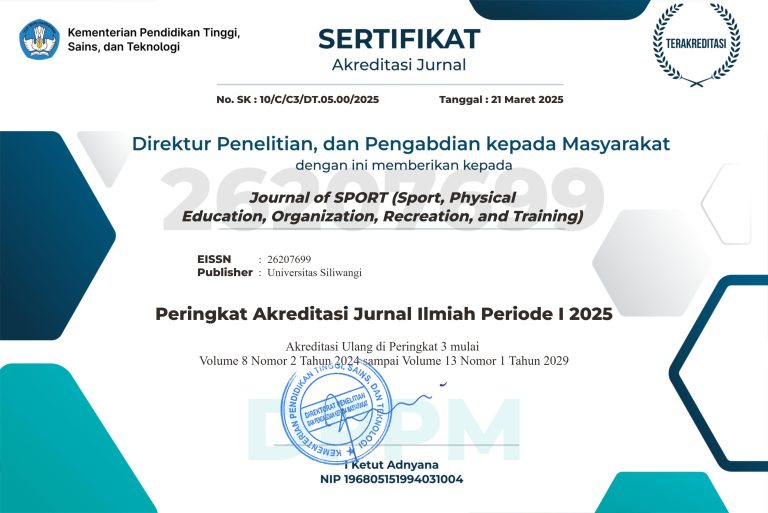Eksplorasi Nilai Karakter Moral Pasca Penerapan Pendekatan Intentionally Structuring dalam Pembelajaran PJOK Studi Kualitatif pada Implementasi Kurikulum Merdeka
Abstrak
Kata Kunci
Teks Lengkap:
PDFReferensi
Ames, C. (1992). Classrooms: Goals, structures, and student motivation. Journal of Educational Psychology, 84(3), 261.
Bean, C., & Forneris, T. (2016). Examining the importance of Intentionally Structuring the youth sport context to facilitate positive youth development. Journal of Applied Sport Psychology, 28(4), 410–425.
Bean, C., Kramers, S., & Harlow, M. (2022). Exploring life skills transfer processes in youth hockey and volleyball. International Journal of Sport and Exercise Psychology, 20(1), 263–282. https://doi.org/10.1080/1612197X.2020.1819369
Braun, V., & Clarke, V. (2006). Using thematic analysis in psychology. Qualitative Research in Psychology, 3(2), 77–101.
Bronfenbrenner, U. (2005). Ecological systems theory (1992).
Creswell, J. W. (2018). Research Design Qualitative, Quantitative, and Mixed Methods Approaches Fifth Edition. In Angewandte Chemie International Edition, 6(11), 951–952.
Holt, N. L., Neely, K. C., Slater, L. G., Camiré, M., Côté, J., Fraser-Thomas, J., Macdonald, D., Strachan, L., & Tamminen, K. A. (2017). A grounded theory of positive youth development through sport based on results from a qualitative meta-study. International Review of Sport and Exercise Psychology, 10(1), 1–49. https://doi.org/10.1080/1750984X.2016.1180704
Jahrir, A. S., Adam, A., & Kamaruddin, S. A. (2024). Values of Physical Education and Sports as Character Development and Strengthening. 6(2), 220–229.
Kemendikbudristek BSKAP. (2022). Salinan Keputusan Kepala Badan Standar, Kurikulum, dan Asesmen Pendidikan, Kementerian Pendidikan, Kebudayaan, Riset, dan Teknologi Nomor 008/H/KR/2022 Tentang Capaian Pembelajaran Pada Pendidikan Anak Usia Dini Jenjang Pendidikan Dasar dan Jenjang Pendid. In Kemendikbudristek (Issue 021).
Krueger, R. A., & Casey, M. A. (2015). Focus group interviewing. Handbook of Practical Program Evaluation, 506–534.
Laidoune, A., Zid, C., & Sahraoui, N. (2022). Innovate and overcome resistance to change to improve the resilience of systems and organizations. Journal of the Knowledge Economy, 13(4), 2986–3001.
Lyle, J., & Cushion, C. (2010). Sports Coaching Conceps.
Miles, E., & Crisp, R. J. (2014). A meta-analytic test of the imagined contact hypothesis. Group Processes & Intergroup Relations, 17(1), 3–26.
Mustafa, P. S., & Dwiyogo, W. D. (2020). Kurikulum pendidikan jasmani, olahraga, dan kesehatan di Indonesia abad 21. Jurnal Riset Teknologi Dan Inovasi Pendidikan (JARTIKA), 3(2), 422–438.
Nation, U. (2004). Sport for Development and Peace : Towards Achieving the Millennium Development Goals. Report from the United Nations Inter-Agency Task Force on Sport for Development and Peace. The Lancet, 365(9464), 1029–1030. https://doi.org/10.1016/s0140-6736(05)74222-7
Patton, N., Aslam, T., MacGillivray, T., Pattie, A., Deary, I. J., & Dhillon, B. (2005). Retinal vascular image analysis as a potential screening tool for cerebrovascular disease: a rationale based on homology between cerebral and retinal microvasculatures. Journal of Anatomy, 206(4), 319–348.
Stake, R. (2004). Stake and responsive evaluation. Evaluation Roots: Tracing Theorists’ Views and Influences, 203, 217.
Watanabe, M. E. (2020). The United Nations Sustainable Development Goals. BioScience, 70(3), 205–212. https://doi.org/10.1093/biosci/biz155
Yin, R. K. (2018). Case study research and applications (Vol. 6). Sage Thousand Oaks, CA.
DOI: https://doi.org/10.37058/sport.v9i3.16909
Refbacks
- Saat ini tidak ada refbacks.
##submission.copyrightStatement##
Journal of SPORT (Sport, Physical Education, Organization, Recreation, and Training)
Program Studi Pendidikan Jasmani
Fakultas Keguruan dan Ilmu Pendidikan
Universitas Siliwangi
Jl. Siliwangi No. 24 Kota Tasikmalaya - 46115
email: penjas@unsil.ac.id
e-ISSN: 2620-7699 ; p-ISSN: 2541-7126

This work is licensed under a Creative Commons Attribution-ShareAlike 4.0 International License.
INDEX BY
1.png)










 Scopus Id:
Scopus Id:  ORCID:
ORCID:  Google Scholar:
Google Scholar: 


